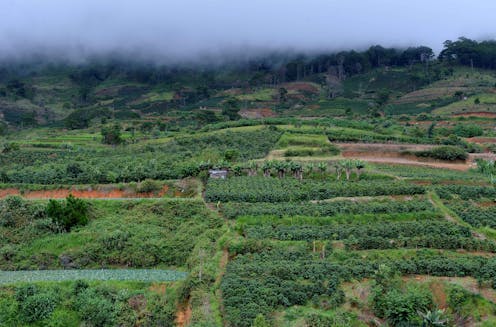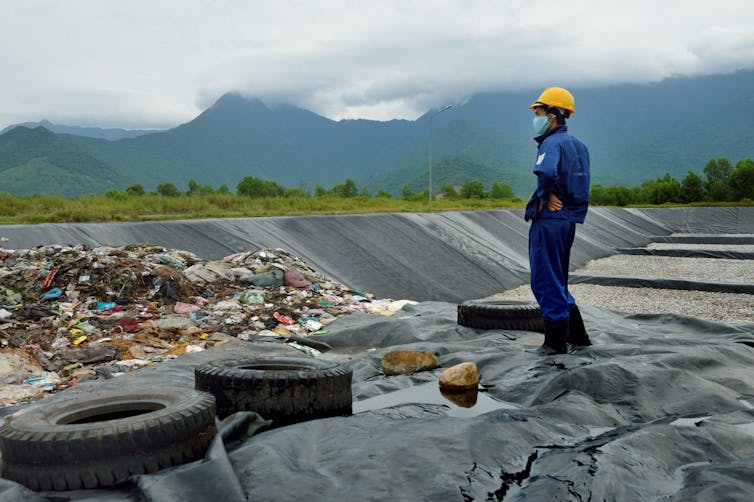
This article was co-written by Frédéric Thomas (CNRS, laboratoire MIVEGEC), Thi Phuong Linh Huynh (IRD), Toan Thuy Le (CESBIO), Thi Thu Ha Nguyen (LASTA), Truong Toan Nguyen (University of Queensland), Tu Anh Nguyen (IMHEN), Frédéric Thomas (IRD), Chi Quang Truong (CTU), Quoc Thanh Vo (CTU), and Canh Toan Vu (ISET).
Vietnam is often presented as one of the countries that are most vulnerable to climate change. But what precisely would be the social and economic impacts in the country if the global average temperature increases by 1.5°C, 2°C or even more in the coming decades? Could local drivers of environmental changes worsen these impacts and what could be the policy and endogenous leverages for adaptation?
Recent temperature data for Vietnam show an accelerating warming trend in the recent decades, with an average value of ~0.2°C/decade over the last 40 years and the highest increase in the last decade. Over the same period, the annual rainfall slightly increased by 5.5% on average, but with contrasting trends depending on regions. In addition, sea level is rising, with an average trend of 3.6 mm/year over 1993–2018. A new climate dataset has been built specifically for this report to evaluate more clearly the recent climatic trends over the whole country.
Regarding future climate projections, at the end of the century, temperature is projected to increase from ~1.3°C under a scenario of low greenhouse gases global emissions (scenario RCP2.6) and to ~4.2°C under a high emissions scenario (scenario RCP8.5), with faster increases on the North of the country than in the South. Annual rainfall is projected to increase in most regions as well, but with a different seasonal distribution. This is the result of a bias-correction downscaling technique, that we used to improve the spatial resolution of projections from global climate models. The new downscaled data enable everyone to quantify the changes in climate variables such as temperature and precipitation over the country’s different regions.
Even if it is difficult to reconstruct more long term climate data before the early 20th century for Vietnam, on can rely on proxies for environmental change, or from historical archives, which have their own bias. But this embryonic environmental history already shows that Vietnamese society has long lived in the middle of climate events. What is particularly interesting in Vietnam climate history is the early emergence of political structures that echo the constant need to adapt to or control natural events. Even if the climate issue was not the same as it is today, there were already political responses to climatic hazards that can highlight today’s climate actions as well.
At the forefront of local and global pressures
The Mekong River delta is one of the largest deltas in the world, currently home to 17 million people and supplying more than half of Vietnam’s rice production. The region is facing several threats: some arise from ongoing climate change, and others from human activities in the delta or upstream. Global climate change will drive rising temperature and precipitation changes in the delta, just as in other regions of Vietnam, but the very low elevation of the delta makes it a hotspot for another threat: rising sea level. Indeed, the average altitude of the delta is only about 80 cm above present sea level. Projections of future sea-level rise for the end of the century range between +24 cm to +84 cm, depending on the climate scenario, which means that large parts of the delta could fall below sea-level by the end of the century, or even earlier, should worst-case scenarios of polar ice-sheet destabilization become reality.

However, in the short to mid-term, parts of the delta may fall below sea-level not because of climate change but because of human activities in the delta. The delta is actually losing elevation, at a rate much higher than global sea-level rise. Groundwater over-extraction is driving subsidence, which is the gradual lowering of the land surface because of sediment compaction. Subsidence rates can reach several centimeters per year in some places. The current rate of sea-level rise is about 3.6 mm/year while the rate of subsidence reaches up to 5 cm/year.
In addition, the delta also faces increasing saline water intrusions in surface waters during the dry season, with negative impacts on agriculture and aquaculture. The phenomenon is mainly driven by riverbed level erosion, caused by sediment starvation from upstream dams and sand mining. In the coming decades, riverbed erosion actually appears as the greatest factor which could drive large increases in saline water intrusions. In a worst-case scenario, areas affected by salt intrusion could increase by nearly 40% by midcentury, decreasing fresh water availability and the area suitable for rice cropping during dry season. In these extreme scenarios, we found that about 140,000 ha (10%) of current winter-spring rice cropping area would no longer be suitable for rice cultivation.
Thus, controlling groundwater extraction and sand mining appear as the most efficient mitigation measures to limit elevation loss and saline water intrusions in the coming decades. On the ground however, farmers can partly adjust their techniques, but they would also face the dire necessity to switch crop or even migrate when yields become too low… In the end, adaptation strategies always combine a mix of endogenous decisions and governmental decisions that interact and influence each other.
Socio-economic impacts at the national level
At the national level, it is possible to estimate the impact of climate variability on some key social aspects and economic sectors. For instance, using monthly data on mortality rate during the 2000-2018 period, we find robust evidence on the effect of extreme temperature, in particular cold and heat waves on mortality. Climate change would also affect the prevalence of many infectious diseases. But health is just the most extreme aspect of the potential impact of climate change on Vietnamese society and households.
Indeed, households could also be affected in their daily life at work. Using the Vietnam Household Living Standards Survey, we find that one additional day that has temperature higher than 33 Celsius degree causes a decline in income, as well as escalated income inequality as low-income families suffered a loss of 1.51% more than other groups. Using the Labor Force Survey, we find that a 1°C rise in temperature leads to a 0.5% expansion in gender hourly wages gap. On the demand side of the labor market, using the Vietnam Enterprise Survey, our research shows that an increase in temperature would reduce firms’ revenue, total factor productivity, output, and size.
In the energy sector, as temperature increases, demand for electricity rises. It is estimated that a 1 degree Celcius increase would raise residential electricity consumption by about 5% and firm electricity consumption by 4%. In addition, energy using fossil fuels releases more pollutant emissions. On the supply side, our study focuses on the hydropower sector and water flow in main river basins in Vietnam. Most climate forecasts say that increased precipitation will enable hydropower production to rise in the future. However, more variability in rainfall during a year will need more investment in bigger water reservoirs to store water for hydropower generation.
These impacts on some key economic sectors of the Vietnamese economy build up an aggregate direct damage over Vietnam of ~4.5% for a 1.5°C increase in global average temperatures, and ~6.7% GDP loss for a 2°C increase in global average temperature. Of course, economic sectors are not autonomous from each other or from the rest of the world. They interact through intermediate consumptions, exports and imports, but also through the financial interlinkages with the rest of the world and more broadly the decisions of the financial sector. By plugging the direct damages into a macroeconomic model, i.e. mainly the impacts on rice, the energy sector, labor productivity, technical change, but also mortality and health, we estimated that on average, the macroeconomic damages are 30% higher than the direct damages. This result shows how crucial it is to not just stop at the sectoral level but also to understand how macroeconomic linkages might amplify the climate impacts.
Adaptation strategies as development strategies
At the level of the Mekong region, local adaptation decisions are insufficient. Cooperation over the use of water is central to the region adaptation and mitigation capacity. Transboundary governance becomes part of the urgent need to move toward a just transition and with the general principle that water is a basic need and right of every Mekong inhabitant. The recent Mekong River Commission initiative called “proactive regional planning” could play an integrative role, via joint mitigation investment projects and adaptation measures between countries, actors, and sectors.
For decades, Vietnam has been working to improve the country’s adaptation policy framework. As a result, significant progress has been made to strengthen community resilience and adaptive capacity, reduce natural disaster risks, and limit climate change impacts. However, vulnerability and risk issues have not been adequately reflected in climate change adaptation and disaster prevention strategies, particularly in infrastructure development, due to a lack of appropriate evaluation and decision-support tools. Meanwhile financing and international aid is lagging behind.
It should be clear however that major challenges will not be only addressed by increasing financing as some adaptation projects or even policies do not clearly contribute to reducing risks and vulnerabilities. Just as adaptation is the result of complex interactions between planned policies and individual choices, it is the complex interplay between official climate change finance and local social dynamics that shapes the structure of adaptation funding. In a region such as the Mekong Delta, people have been adapting to changing conditions for centuries and continue to do so even in the absence of policy incentives or constraints, as evidenced by the major land-use changes that have taken place over the past two decades.
It is therefore necessary to consider approaches and decision support models that take into account both spontaneous and planned adaptation, as both are sources of innovation or major changes in system dynamics. There is also an urgent need to develop and implement comprehensive planning, monitoring and evaluation systems for adaptation and more generally to mainstream adaptation into the whole development planning and budgeting processes of the country.
Adaptation to the inevitable impacts of climate change is thus a matter of development strategy for Vietnam, in parallel with its own ambitious contribution to the necessary emission reduction efforts announced at COP26.
Alexis Drogoul's current research projects receive funding from the European Union, the French National Research Agency and ANRS-MIE.
Emmanuel Pannier a reçu des financements de Institut de Recherche pour le Développement, Agence Française de Développement, Ambassade de France au Vietnam, Agence National de la Recherche (France).
Manh-Hung Nguyen, Marie-Noëlle Woillez, Thanh Ngo-Duc et Étienne Espagne ne travaillent pas, ne conseillent pas, ne possèdent pas de parts, ne reçoivent pas de fonds d'une organisation qui pourrait tirer profit de cet article, et n'ont déclaré aucune autre affiliation que leur poste universitaire.
This article was originally published on The Conversation. Read the original article.







